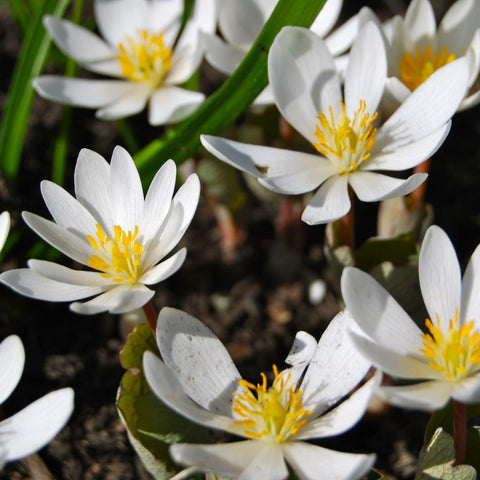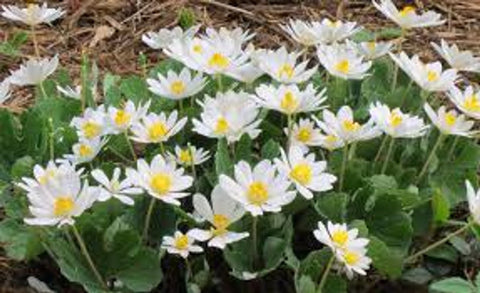

Bloodroot Plant - Sanguinaria
Bloodroot is a native flowering plant found in the United States. This native wildflower is best grown in moist areas such as by a river, pond, or swamp. Bloodroot plants usually grow around two feet in height and put out lots of small white flowers. The bloodroot plant is easy to recognize with its blood-colored root that can be found near the ground's surface. Here we will discuss all you need to know about the plant.
1. Description of the Bloodroot
The bloodroot blooms in early spring and has pretty white flowers with violet-colored spots in the center. In addition, bloodroot is an herbaceous perennial plant that produces a thick rhizome. The rhizome is pinkish-red and is part of the bloodroot plant used for medicinal purposes. The bloodroot plant has numerous leaves arranged alternately, which means they grow opposite each other on the stem. The stem of the bloodroot plant is typically made out of many branches, and it is reddish. The stem is hollow and filled with earthy tissue that is green in color. The roots are blood-colored at the surface, and below that, they are white. They form underground tubers of a fleshy consistency.
2. Why the Bloodroot Plant is a Good Choice to Buy
Bloodroot plants can be used as an herb or as medicine. It has been used traditionally by American Indians to cure blood disorders, and its roots are used for medicinal purposes. Due to its ability to treat various illnesses and diseases, this native wildflower is a great choice for homeowners who want an inexpensive medicinal herb. In addition, it is also an excellent choice for landscapers who want to add color to their yards. The tubers of the plant can be used to keep insects away naturally. The leaves of the bloodroot plant are fleshy and large and are used as food by wildlife in gardens.
3. How to Grow Bloodroot Plant
The best way to grow a bloodroot plant is to start from tubers instead of seeds. Tubers can be planted in well-drained areas with a pH of 7.5 - 8.5. The tubers can also be planted in containers in indoor environments, and the soil should have proper drainage and a pH level of 7.5 - 8.5. You can grow bloodroot in pots to control the plant's environment. Bloodroot is recommended for homeowners who want a well-kept plant inside their home or near a pond or garden. The plant cannot tolerate extreme weather conditions, so growing it indoors will ensure its survival during the winter season and protect it from getting scorched by the sun during the summer season.
4. Benefits of Bloodroot
Bloodroot root can be used to treat a variety of illnesses. Bloodroot root has several medicinal properties and is thought to contain alkaloids. It has been traditionally used for centuries as a traditional medicine by American Indians. Bloodroot is very easy to grow and does not need much maintenance. The tubers can be stored for up to six months to a year, requiring light exposure to sprout into a new plant. Also, the plant is native to the United States, beautifying their gardens naturally.
5. When to Harvest Bloodroot
Bloodroot root is usually harvested in the summer and is only used in the winter. It is recommended to harvest it when the rhizomes have formed into tubers. Harvesting can be done by hand and should be carefully done so as not to damage the rhizome or break off any parts of the plant. The tubers can be used for medicinal purposes, and they are harvested at a time when they are large enough to store easily.
Bloodroot plant is an excellent addition to any garden or yard and as a medicinal herb. Bloodroot is native to the United States and can be used to attract wildlife like bees, butterflies, and birds. Landscapers can use its thick rhizome to keep insects away from plants in the garden or yard.
FAQ
1. Do Bloodroot plants spread?
A. Bloodroot has thick, fleshy rhizomes (underground stems) that grow horizontally beneath the soil surface. These rhizomes give rise to new shoots and allow the plant to spread and form colonies over time.
2. Is Bloodroot easy to grow?
A. Yes, Bloodroot is very easy to grow. Bloodroot prefers partial to full shade. It is well-suited for shaded or woodland gardens. When planting, choose a location with dappled sunlight or filtered light.
One Year Guarantee on all Perennials & Ferns. See Healthy Plant Guarantee for more details.
Color:
White
Ships As:
Root/Rhizome
Season:
Spring
Zone:
3-8
Exposure:
Full to Partial Shade
Deer Resistant:
Yes
Native:
Yes




